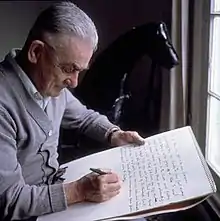Jean Paul Lemieux | |
|---|---|
 Lemieux in 1977 | |
| Born | Marie Joseph Jean Paul Lemieux November 18, 1904 Quebec City, Canada |
| Died | December 7, 1990 (aged 86) Quebec City, Canada |
| Education |
|
| Spouse | Madeleine Des Rosiers |
Jean Paul Lemieux, CC RCA GOQ (1904 - 1990) was one of the foremost twentieth century painters in Canada. He worked in several different styles, as represented by his five artistic periods.
Biography
He was born in Quebec City, where he also died. He was raised in Quebec City until 1916, when his family moved to Berkeley, California. In 1917, the family returned to Quebec and settled in Montreal.[1]
As a youth, Lemieux created watercolours, taking lessons in his teens from an "English lady" in Montreal.[2] From 1926 to 1934, Jean Paul Lemieux studied with Edwin Holgate and others at the Montreal School of Fine Arts. In 1929, he traveled to Europe with his mother. In Paris, he studied advertising and art and met other artists. Lemieux took teaching positions from 1934, first at his former school, then in 1935 at the École du meuble. In 1937, he moved to Quebec City and taught at the École des Beaux-Arts de Québec until his retirement in 1965. His connections at that period include other major artists associated with these schools, such as Alfred Pellan and Paul-Émile Borduas.[1]
In 1960, works by Lemieux along with Edmund Alleyn, Graham Coughtry, Frances Loring and Albert Dumouchel represented Canada at the Venice Biennale.[3]
Awards and honors
Jean Paul Lemieux received several awards for his works, including the Louis-Philippe Hébert prize in 1971 and the Molson Prize for the Canada Council for the Arts in 1974. In 1968, he became a Companion of the Order of Canada. He was also a member of the Royal Canadian Academy. In 1997, he was posthumously made a Grand Officer of the National Order of Quebec.
Artistic career
Lemieux's 1979 work affectionate memory images, in the monarch's and governor general's residence at la Citadelle, in Quebec City
|
Lemieux was a representational artist whose painting career sometimes had echoes of folk art but, in 1956, at the age of 52, he changed his subject matter and refined his technique. The paintings which followed are among his best known. They usually feature emblematic scenes of French Canada, often combined with a sense of the vast spaces of his homeland.
Works - a selection
- Marine, Baie Saint-Paul, 1935[1]
- Notre-Dame protégeant Québec, 1941
- Portrait de l’artiste à Beauport-Est, 1943
- Le Far West, 1955
- Les Parques, 1962
- L’été de 1914, 1965
- Her Majesty Queen Elizabeth II and His Royal Highness The Duke of Edinburgh, 1979
- Dies Irae, 1982–83
The five periods
The Musée national des beaux-arts du Québec and other sources[1] divide Lemieux's career into five periods:
- Montreal period (1926–1937), marked by realistic naturalism influenced by Quebec regionalism and, later, European post impressionism.
- Primitive period (1940–1947), focused on anecdote and accumulated scenic detail.
- Minimalist period (1951–1955), with cubist structures, which signaled a major turning point in the artist's career.
- Classical period (1956–1970), with a figures fuelled by the sources and practices of abstract art (MNBAQ). It is in this period that Lemieux produced the paintings of lonely figures in desolate, bleak landscapes for which he is so well known today.
- Expressionist period (after 1970), presenting humanity living in a post nuclear attack world.
Legacy

A set of postage stamps depicting three works by Lemieux, Self-portrait (1974), June Wedding (1972) and Summer (1959) were issued by Canada Post on October 22, 2004. The stamps were released on the day that a retrospective of his work organized to recognize the centenary of the artist's birth opened at the National Gallery of Canada.[4] The Musée national des beaux-arts du Québec (abbreviated as MNBAQ) held the exhibition Jean Paul Lemieux: Silence and Space in 2022.
The Jean Paul Lemieux and Madeleine Des Rosiers fonds, R6612, is in Library and Archives Canada.
References
- 1 2 3 4 Grandbois, Michèle. "Jean Paul Lemieux - Biography". www.aci-iac.ca. Art Canada Institute. Retrieved May 15, 2020.
- ↑ Grandbois, Michèle. "Works". www.heffel.com. Heffel Auction House, Post-War & Contemporary Art November 23, 2023. Retrieved November 2, 2023.
- ↑ "Past Canadian Exhibitions". National Gallery of Canada at the Venice Biennale. National Gallery of Canada. Archived from the original on October 13, 2013. Retrieved October 12, 2013.
- ↑ "Art Canada: Jean Paul Lemieux". Canada Post. Archived from the original on October 17, 2013. Retrieved October 13, 2013.
Sources
- Brulotte, Gaëtan (1996). L'Univers de Jean Paul Lemieux. Québec: Les Editions Fides. ISBN 2762117356.
- Tel qu’en Lemieux, produced and directed by Guy Robert in the artist's Quebec City studio (L’Office du film du Québec, 1973).
External links
- Images and galleries
- Painting: The Visit
- Gallery from the Canadian government's Cybermuse project.
- Small gallery from Virtual Museum of Canada.
- Information
- Short biography (in French) from the Université de Sherbrooke website.
- Criticism and interpretation
- The introduction to the Gaëtan Brulotte book (see: References), written by Anne Hébert.
_39.jpg.webp)